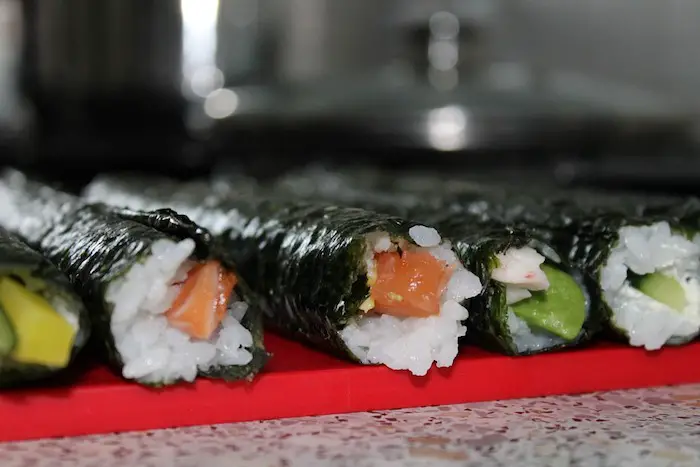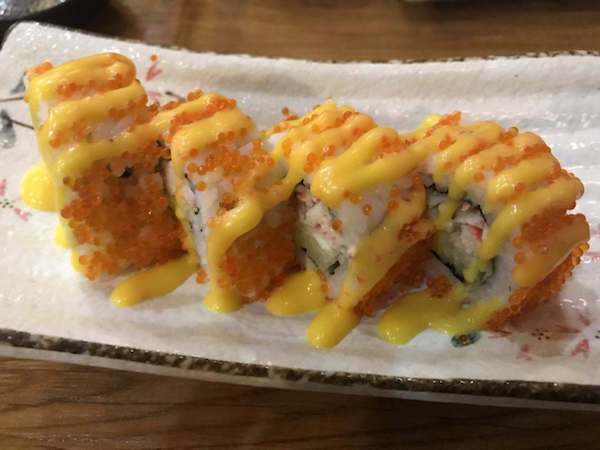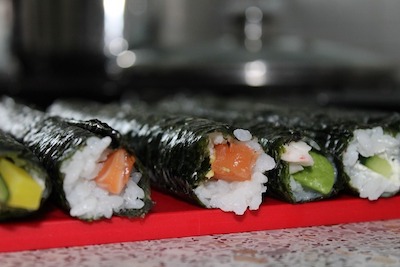We are reader supported. When you purchase through links on our site, we may earn an affiliate commission. Also, as an Amazon affiliate, we earn from qualifying purchases.

If you are a beginner at sushi eating, you need to be careful about what you order because your choice can make or break your interest in this delicacy. The world of sushi is extremely diverse in terms of flavors, textures, and taste. With so many different options for fillings, no two dishes taste the same.
Besides sushi ranging widely in terms of taste, people’s preferences also vary a lot. As a result, I highly recommend beginners to try something safe and give this 2000-years old Japanese delicacy a fair chance to impress you.
As a first time eater, don’t jump into trying a uni gunkan sushi or unagi sushi roll as your taste buds may not be ready to appreciate them. Some highly prized ingredients used in sushi may be labeled as ‘gross’ by beginners because they need an acquired taste.
Trying the wrong sushi for the first time may leave you with a bad taste and you may give up entirely, thinking that sushi is not your kinda food. Thus, you end a chapter without even exploring the different possibilities and you will forever remain unknown to sushi.
Worse still, you may go on telling your family members, relatives and friends that sushi tastes gross and refrain them from the opportunity to discover the culinary delight. Interestingly, 9 out of 10 people who did not like sushi first time went wrong with their order.
If you are on the threshold of exploring the world of sushi for the first time, you are lucky to be here. I have created this list of best sushi rolls for beginners to give you a fair chance at discovering the amazing flavors and mouth-watering taste of sushi
Contents
California Rolls Are Your Best Bet

Regardless of whether you are an adventurous eater or not, I would suggest that you start your culinary journey into sushi with a maki roll. California sushi roll is the safest option as it does not contain raw fish or seafood, which beginners may find intimidating.
Most people have tasted crab meat before so whether the California roll has real crab or imitation crab sticks, the dish tastes great. It is further paired up with avocado and cucumber to add more crunchiness to the roll.
Some beginners may not like the green Nori, so a California roll with its inside-out style hides the seaweed under a layer of seasoned rice. You will hardly know it’s there! Enjoy your sushi with soy sauce and wasabi served alongside the dish and you will want to come back again. Just remember to follow a few sushi etiquettes that I have mentioned towards the end of this post for a pleasant experience.
Shrimp Tempura Rolls Are Always Bang On
If you love seafood then I would recommend that you try a shrimp sushi roll as they are both filling and delicious. Order a shrimp tempura roll to enjoy the crunchy texture of tempura balanced perfectly with the seasoned rice and avocado slices. It never fails to impress.
Another good cooked option is the spicy shrimp roll that can expose you to a variety of delicious flavors and textures. I would recommend that you try to order simple rolls that contain 2-3 ingredients at the maximum to be able to enjoy their taste without getting overwhelmed.
King Crab Rolls Are A Winner
If seafood makes you happy, pair them up with your sushi to enjoy those guilty pleasures. The delicious crab tempura and creamy mayonnaise inside the roll will make sushi your go-to food when you wish to pamper your taste buds.
The sushi roll may come with some variations, such as crab tempura may be paired up with cucumber or carrots to add some veggies to the dish. If you don’t like imitation crab meat, the King crab roll will give you the pleasure of tasting the original thing.
Alaska Sushi Rolls Can’t Go Wrong
This is my other all-time favorite that tastes heavenly with the afternoon tea. If I had to introduce someone to salmon sushi, I would, by all means, order the Alaska roll. It contains smoked salmon which strikes out the raw factor and helps in bringing out the exotic flavors of the food.
Again, being an uramaki-style roll, newbies don’t have to deal with the green nori exterior on the sushi roll. The colorful topping not only makes the roll attractive in appearance but also extremely delicious in taste.
Philadelphia Rolls Offer Guilty Pleasures

When talking about the best sushi rolls for beginners, the Philadelphia Roll deserves a mention for sure. I have several American friends who swear by this roll, which makes me feel this was specifically created to woo the westerners.
The roll may be made in the traditional style with nori outside or inside-out style with the seaweed hidden under rice. It typically contains smoked salmon, cream cheese, and cucumber. Some variations of the roll may include some extra ingredients like another type of fish, scallions, avocado, and sesame seed.
Vegetable Sushi Rolls Are The Safest
If fish, seafood or meat are not your ‘thing’, it doesn’t mean you cannot enjoy sushi. Some of the most traditional maki rolls in Japan contain only cucumbers and avocados. The options don’t end there as you can enjoy a plethora of other vegetables such as sweet potato, carrot, daikon radish and so on.
You may also use green vegetables such as scallions, bean sprouts, and asparagus to name a few. Besides the fresh and semi-boiled vegetables, the pickled delicacies also find an important place in Japanese cuisine.
Negimaki Sushi Rolls Are A Savory Delight
This type of sushi works best for people who don’t like the taste of seafood, whether raw or cooked. Also known as meat sushi, this variation includes thin and savory strips of cooked beef or chicken rolled around spring onions.
With negimaki, beginners can enjoy sushi without having to eat raw fish or seafood. Chicken is often paired up with vegetables like cucumber or avocados to add freshness to the roll.
Tuna Sushi Rolls Are The Ice-Breakers

When you are comfortable with the cooked sushi options, you may go further explore and enjoy the new horizons. I recommend your first ‘raw fish’ sushi experience to be a tuna roll. Also known as Maguro in Japanese, tuna is an extremely popular and delicious fish that has sweet and delicate flavors.
As tuna is a large sized fish, cuts from different parts of the body are used in making sushi. When starting out, always opt for the leaner portion (akami) and once you get acclimatized to it, you may try out the richer toro from the fatty belly part of the fish.
Sushi-grade raw fish does not have a fishy smell so don’t worry about your food tasting like raw chicken out of the sea. If you like raw tuna sushi, you may next try the bolder variations such as eel or salmon sushi.
Go For Inari Sushi Instead

Well, this is not a typical sushi roll but offers a good alternative for beginners who find sushi intimidating. That brown pouch you see on the outside is called tofu and it holds seasoned rice mixed with sesame seeds inside.
There are no extra fillings, no meat or whatsoever. So, you just get to enjoy the sweet and savory rice filled up in the delicious brown pouch. If you are new to sushi and don’t know what to order at a sushi bar, you can safely ask for inari sushi.
5 Tips To Order Sushi Correctly First Time
If you have not eaten sushi before, it’s natural to feel a little intimidated about your first order. Now, that you have decided to finally discover the taste of sushi, here are five tips to ensure a pleasant experience for you.
#1. Basics before going to the sushi restaurant
The quality of ingredients used in sushi can be the deal maker or breaker, so always go to a restaurant that has good reviews from customers. According to Hidekazu Tojo, a world-renowned chef, a good sushi restaurant should smell of cucumbers or watermelons.
If the restaurant smells fishy, chances are they do not use sushi-grade fish for food preparation and you must avoid such places. Better still, always ask a friend who has eaten sushi before and knows about the sushi restaurants in your locality to accompany you for the first time.
Another important fact about sushi rolls is that they can be of different types, such as nigirizushi, maki rolls, temaki, uramaki (inside-out) and so on. Maki is the traditional sushi roll that constitutes of vinegared rice, fish (cooked or raw), and vegetables rolled in a toasted seaweed or Nori. It is then cut into 6-8 bite-sized portions.
#2. Know the condiments served with sushi
The sushi plate will include a small bowl of soy sauce for you to dip your rolls slightly into it and eat. At the side, you will see an extremely pungent green paste which is called wasabi. Originally, wasabi is prepared by grating the wasabi root but you will find the fake wasabi in most restaurants. Instead of the real thing, it contains a mix of horseradish, corn filler, mustard seed, and cabbage.
Pickled ginger or gari is the pink colored condiment served at one side of the plate. It should be eaten in between sushi pieces to cleanse the palate so that you can enjoy the flavors of different types of fish. Just take a small bite of gari after eating a piece of sushi.
#3. What to order at a sushi restaurant
It’s natural to feel confused when you look at the menu because you have no idea what the food will taste like. For newbies, I would suggest that you directly ask the chef for recommendations. Order a few items and then repeat the ones that you liked.
Tell the chef that you are eating sushi for the first time, and he will be more than glad to make the experience enjoyable for you. The menus are no more limited to just raw fish and you can find a variety of options ranging from chicken, beef, and tempuras to tofu and vegetables.
#4. Start with the cooked sushi rolls first
As mentioned above, be on the safer side by ordering the cooked sushi rolls to get familiar with the taste and texture of sushi. Once you are comfortable, experiment with a tuna sushi roll if you are feeling adventurous. Some types of seafood such as uni and eel need an acquired taste so don’t jump into ordering them yet.
For sushi beginners, my formula is to start with California roll and tempura roll, then move to smoked salmon sushi, and at last try tuna sushi. You can leave uni, taco, awabi (abalone), tobiko and eel for the next visit.
If you are confused about what to order and are too shy to ask the chef, take a look at the menu carefully. The menu will usually have ingredients listed alongside each dish. Look for the familiar ingredients and order what you already know. You can also have a look my previous article for more cooked sushi
#5. Play safe with vegetable sushi rolls
If you are not ready to order fish or seafood (whether cooked or raw), why not stick to veggies only. You will be surprised to know that there are some really exotic vegetable sushi rolls such as sun-dried tomato sushi rolls, shitake mushroom rolls, grilled tofu rolls, avocado rolls and so on.
8 Sushi Etiquettes You Must Know
#1.Greet your chef as you enter the sushi restaurant. It’s okay to ask the chef for recommendations but don’t ask questions like ‘Is that fresh fish?’
#2. Don’t take the chef’s picture without asking for his permission. You may, however, take pictures of the food and then keep your phone away while eating.
#3. You will be given a hot or damp towel to clean your hands before you eat. Fold it neatly after you wipe your hands and keep it back.
#4. You will be given chopsticks to pick your sushi, but if you are not comfortable using them, use your hands or ask for a fork/ spoon. Avoid rubbing chopsticks as it is considered impolite.
#5. Don’t pour extra sauce on your sushi without tasting it. The chef already adds sauce so take a bite and then decide if you need to any more condiments. Dip one end of the sushi in sauce and eat immediately. It is rude to leave unused sauce on your plate with fallen rice on it.
#6. Nigirizushi and sushi roll pieces are meant to be eaten at once. The chef painstakingly creates the perfect form for nigiri and cuts the roll into bite-size pieces. So, respect the art and try to eat the entire pieces together or take two bites at the most, without letting it fall apart.
#7. Don’t overdo the wasabi or your food will be too hot for you to eat. The chef already adds some wasabi to your sushi, so don’t add extra without tasting.
#8. It’s considered rude to leave food on your plate so make sure you eat all sushi and thank the chef for a wonderful meal. You may buy a sake or beer for the chef as a mark of appreciation. The chef will remember your kind gesture and serve you with more enthusiasm next time.
If you are visiting Japan anytime soon, the article is perfectly-timed for you. Also, read my another post that talks about how to eat sushi in Japan and learn about the sushi etiquettes in detail.

